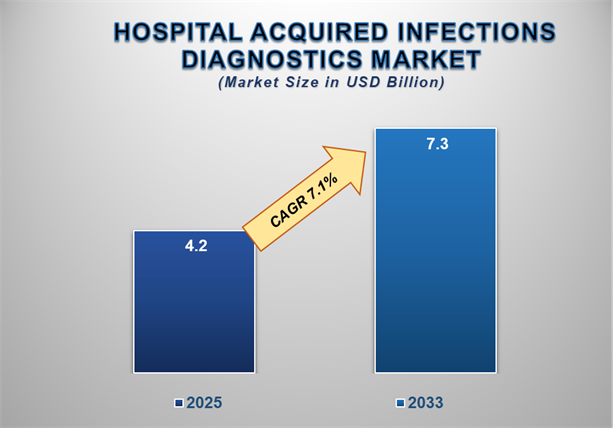Hospital-Acquired Infections: The Growing Role of Rapid Diagnostics in Patient Care

Exploring the Market for Hospital‑Acquired Infections (HAI) Diagnostics
Hospital‑acquired infections (HAIs), sometimes referred to as nosocomial infections, represent a profound challenge for modern healthcare systems: patients who enter a hospital for one condition may leave with another unintended infection acquired in the care setting. The market for diagnostics that detect, monitor and help prevent these HAIs is growing rapidly and evolving in interesting ways. Here’s a detailed look at where things stand, what’s driving growth, what’s holding things back, and what the future might hold.
What are HAIs & why diagnostics matter
HAIs occur when a patient acquires an infection during their care in a hospital, clinic or long‑term care facility, unrelated to the original reason for admission. They include urinary tract infections (often catheter‑associated), surgical site infections, ventilator‑associated pneumonia, bloodstream infections and infections from C. difficile, among others. A key problem is that these infections increase morbidity and mortality, prolong hospital stays, raise healthcare costs and fuel antimicrobial resistance.
Diagnostics play a critical role: early, accurate detection of the pathogen (and its resistance profile) enables timely treatment, helps prevent spread to other patients, supports infection control measures and thus helps reduce overall burden. With improved diagnostics, hospitals can identify outbreaks faster, tailor treatments more precisely and implement preventive strategies more effectively.
Market size & growth trends
There is some variation in reported figures because different studies use different scopes, base years and assumptions — but the general story is one of significant growth.
-
One source estimates the global HAI diagnostics market size at about USD 4.09 billion in 2022, projected to reach USD 7.80 billion by 2032, at a CAGR of ~6.6%. GlobeNewswire
-
Another reports a base of ~USD 4.5 billion in 2022, with a “~8%” CAGR through to 2032, reaching about USD 10.2 billion. Global Market Insights Inc.
-
Yet another sees a more modest growth path: about USD 4.3 billion in 2024, rising to ~USD 4.74 billion by 2030, at a CAGR of ~1.49%. Grand View Research
-
For a slightly broader view, one forecast sees the market at USD 7.94 billion in 2024, rising to USD 11.40 billion by 2031 (CAGR ~5.3%). reanin.com
The upshot: there’s consensus that the market is growing, though the rate and absolute size vary. In many reports, molecular diagnostics (PCR, next‑generation sequencing) dominate growth; emerging regions (Asia Pacific, Latin America) are highlighted as key opportunities; and the push toward rapid, point‑of‑care (POC) diagnostics is a strong theme.
Key drivers of market growth
Several factors are fuelling demand in HAI diagnostics:
-
Rising prevalence of HAIs
As hospitals proliferate, surgical volumes increase, older and sicker patients are admitted (geriatric, immunocompromised, ICU patients) and invasive devices (catheters, ventilators) are used more frequently — the opportunities for HAIs go up. Grand View Research+2Global Market Insights Inc.+2 -
Antimicrobial resistance (AMR)
Pathogens that cause HAIs are increasingly drug‑resistant (e.g., MRSA, C. difficile, carbapenem‑resistant Enterobacteriaceae). Rapid, precise diagnostics help identify these threats earlier and guide therapy. Grand View Research+1 -
Technological advancement
Diagnostic tools are becoming faster, more accurate, more multiplexed (detecting multiple pathogens at once), integrated into hospital IT systems, and moving towards POC formats. These innovations open up new use‑cases and drive uptake. strategicmarketresearch.com+1 -
Increasing awareness, regulation & surveillance
Hospitals and regulatory bodies are focusing more on infection control, reporting requirements, patient safety and cost containment. Diagnosing HAIs more effectively ties into these priorities. strategicmarketresearch.com+1 -
Emerging markets
Healthcare infrastructure improvements in countries across Asia Pacific, Latin America and the Middle East are enabling more hospitals and diagnostic labs, and thus more demand for HAI diagnostics. Some reports highlight Asia Pacific as one of the fastest growing regions. visionresearchreports.com+1
Key segments & technologies
By test type & product:
-
Molecular diagnostics (PCR, multiplex assays, NGS) are often the fastest‑growing segment due to their speed and sensitivity. Verified Market Reports+1
-
Traditional microbiology (culture, microscopy) remains significant — particularly in established labs, because of cost and familiarity. Grand View Research+1
-
Consumables (reagents, assay kits, cartridges) often hold the larger share of product spend, though instruments (analyzers, POC devices) are growth levers. Grand View Research+1
By infection type:
-
Urinary tract infections (UTIs) are frequently cited as a major share segment (due to catheter use and prevalence) and good growth potential. Grand View Research+1
-
Bloodstream infections (BSIs), surgical site infections (SSIs), ventilator‑associated pneumonia and gastrointestinal infections (e.g., C. difficile) are also high‐priority because of severity and cost. strategicmarketresearch.com+1
By end‑user / geography:
-
Hospitals (especially tertiary and ICU settings) dominate consumption of HAI diagnostics. Ambulatory surgical centres, diagnostic laboratories and research institutions are also relevant. strategicmarketresearch.com+1
-
Geographically, North America and Europe have large shares currently, while Asia Pacific is often highlighted for higher growth rates. visionresearchreports.com+1
Challenges & restraints
While the opportunity is strong, there are several key headwinds:
-
Cost / reimbursement pressures: High‑end molecular tests and POC systems can be expensive, which may limit adoption in resource‑constrained settings.
-
Infrastructure & training gaps: In many hospitals (especially in low/middle income countries) labs may lack staff, equipment, or protocols to implement advanced diagnostics. Global Market Insights Inc.
-
Regulatory & validation hurdles: Introducing new diagnostic technologies (especially for AMR or multiplex panels) may face strict regulatory pathways and require robust validation.
-
Integration & workflow issues: Diagnostics are only one part of the chain. If results are delayed, not acted on, or not communicated effectively to infection control programmes, the value is undermined.
-
Variability in infection burden/definition: Accurate monitoring and reporting of HAIs can be inconsistent, making it harder to assess market need or the value proposition in some regions.
-
Price sensitivity and competition: As diagnostics become proliferated, pressures on pricing and margins may grow.
TRENDING REPORTS:
https://m2squareconsultancy.com/reports/wearable-medical-devices-market
https://m2squareconsultancy.com/reports/global-energy-drinks-market
https://m2squareconsultancy.com/reports/std-diagnostics-market
https://m2squareconsultancy.com/reports/oncology-drugs-market
https://m2squareconsultancy.com/reports/ultomiris-drug-market
https://m2squareconsultancy.com/reports/sustainable-pharmaceutical-packaging-market
https://m2squareconsultancy.com/reports/syringe-infusion-pumps-market
https://m2squareconsultancy.com/reports/local-anesthesia-drugs-market
https://m2squareconsultancy.com/reports/hospital-acquired-infections-diagnostics-market
https://m2squareconsultancy.com/reports/biopolymers-and-bioplastics-market
https://m2squareconsultancy.com/reports/solar-panel-operation-and-maintenance-market
https://m2squareconsultancy.com/reports/fruit-and-vegetable-pulp-market
https://m2squareconsultancy.com/reports/spiritual-and-wellness-products-market
https://m2squareconsultancy.com/reports/portable-ultrasound-devices-market
https://m2squareconsultancy.com/reports/fecal-immunochemical-diagnostic-test-market
https://m2squareconsultancy.com/reports/next-generation-sequencing-market
https://m2squareconsultancy.com/reports/surgical-operating-tables-market
https://m2squareconsultancy.com/reports/floor-cleaner-market
Future outlook / Emerging opportunities
Looking ahead, a number of trends suggest how the market may evolve:
-
Point‑of‑care (POC) diagnostics and decentralisation: As healthcare moves toward more decentralised and rapid testing models, there is increasing demand for faster diagnostics at or near the patient bedside (rather than only in central labs). For HAIs, this means rapid screening in emergency units, ICU, surgical wards. strategicmarketresearch.com
-
AI / bioinformatics integration: Diagnostics will increasingly be integrated with data analytics, lab informatics and hospital infection control systems — enabling predictive surveillance, outbreak detection and faster response. strategicmarketresearch.com
-
Multiplex / syndromic panels: Instead of testing for one pathogen at a time, future platforms will test for multiple pathogens and resistance genes in a single run — valuable in ICU/ward settings where rapid decisions matter.
-
Emerging markets growth: As hospitals in Asia Pacific, Latin America and Africa modernise, adoption of advanced diagnostics will accelerate — representing a key growth opportunity. Some reports estimate Asia Pacific will lead growth in coming years. visionresearchreports.com
-
Focus on antimicrobial stewardship: Diagnostics that help identify resistance profiles and optimize antibiotic usage will be increasingly important. This ties into overall hospital initiatives on AMR.
-
Cost reduction & decentralised lab models: As technology improves and becomes more affordable, adoption will broaden beyond large tertiary hospitals into smaller facilities and outpatient settings.
-
Outbreak detection & pandemic preparedness: The COVID‑19 pandemic underscored the importance of infection diagnostics; hospitals may invest more in diagnostics infrastructure and capacity for rapid detection of HAIs and outbreaks.
Implications for stakeholders
-
Diagnostics companies: There’s opportunity in developing faster, multiplexed, easy‑to‑use platforms, especially for POC and emerging markets. Partnerships with hospitals and infection control teams can be valuable.
-
Hospitals & healthcare providers: Investment in diagnostics is justified not only for patient safety but for cost‑savings (shorter hospital stays, fewer complications) and regulatory compliance. They must consider workflow integration, staff training and data linkages.
-
Investors / industry watchers: The sector shows solid growth potential, particularly in molecular diagnostics, POC platforms and emerging geographies. However, attention should be paid to reimbursement, regulatory landscape and competitive dynamics.
-
Policy makers & public health authorities: Encouraging adoption of advanced diagnostics, supporting lab infrastructure in lower‑income settings and promoting antimicrobial stewardship can help reduce HAI burden and associated costs.
Conclusion
The market for HAI diagnostics is a vibrant and evolving space. With rising awareness of hospital‑acquired infections, increasing incidence of drug‑resistant pathogens, technological advancement in diagnostics, and growing focus on infection control, the tailwinds are strong. While challenges remain (especially in cost, infrastructure and workflow adoption), the direction is clear: faster, more accurate, and more widely deployed diagnostics will play a central role in managing HAIs.
For companies, healthcare providers and regulators alike, the next few years will be critical: innovation in molecular and POC diagnostics, expansion into emerging markets, and integration into hospital workflows will define winners and losers. For patients, better diagnostics means earlier detection, more precise treatment, fewer complications and ultimately safer care in the hospital setting.
About m2squareconsultancy :
We are a purpose-driven market research and consulting company passionate about turning data into direction. Founded in 2023, we bring together researchers, strategists, and data scientists who believe that intelligence isn’t just about numbers, it’s about insight that sparks progress.
We cater to a wide range of industries by delivering customized solutions, strategic insights, and innovative support that help organizations grow, adapt, and lead in their respective sectors. Here’s a brief overview of key industries we work with.
Contact Us:
Email: sales@m2squareconsultancy.com
Phone (IN): +91 80978 74280
Phone (US): +1 929 447 0100
More Report:
https://m2squareconsultancy.com/reports/organic-personal-care-products-market
https://m2squareconsultancy.com/reports/portable-power-station-market
https://m2squareconsultancy.com/reports/power-transformer-market
https://m2squareconsultancy.com/reports/renewable-energy-market
https://m2squareconsultancy.com/reports/artificial-sweeteners-market
https://m2squareconsultancy.com/reports/blister-packaging-market
https://m2squareconsultancy.com/reports/digital-therapeutics-market
https://m2squareconsultancy.com/reports/drug-discovery-outsourcing-market
https://m2squareconsultancy.com/reports/e-pharmacy-market
https://m2squareconsultancy.com/reports/hospital-acquired-infections-diagnostics-market
https://m2squareconsultancy.com/reports/edible-oil-market
https://m2squareconsultancy.com/reports/solar-panel-operation-and-maintenance-market
https://m2squareconsultancy.com/reports/premium-chocolate-and-confectionery-market
https://m2squareconsultancy.com/reports/health-and-wellness-snacks-market
https://m2squareconsultancy.com/reports/fruit-and-vegetable-pulp-market
https://m2squareconsultancy.com/reports/dehydrated-vegetables-market
https://m2squareconsultancy.com/reports/spiritual-and-wellness-products-market
https://m2squareconsultancy.com/reports/portable-ultrasound-devices-market
https://m2squareconsultancy.com/reports/ophthalmic-lenses-market
https://m2squareconsultancy.com/reports/fecal-immunochemical-diagnostic-test-market
https://m2squareconsultancy.com/reports/sports-medicine-market
https://m2squareconsultancy.com/reports/military-drone-market
https://m2squareconsultancy.com/reports/almond-milk-market
https://m2squareconsultancy.com/reports/smart-shopping-cart-market
https://m2squareconsultancy.com/reports/drone-delivery-services-market
https://m2squareconsultancy.com/reports/smart-vehicle-market
https://m2squareconsultancy.com/reports/global-biopesticides-market
https://m2squareconsultancy.com/reports/financial-app-market
https://m2squareconsultancy.com/reports/cellular-iot-market
https://m2squareconsultancy.com/reports/supply-chain-security-market
https://m2squareconsultancy.com/reports/comic-book-market
https://m2squareconsultancy.com/reports/online-gambling-market
https://m2squareconsultancy.com/reports/beauty-tech-market
https://m2squareconsultancy.com/reports/global-exoskeleton-market






